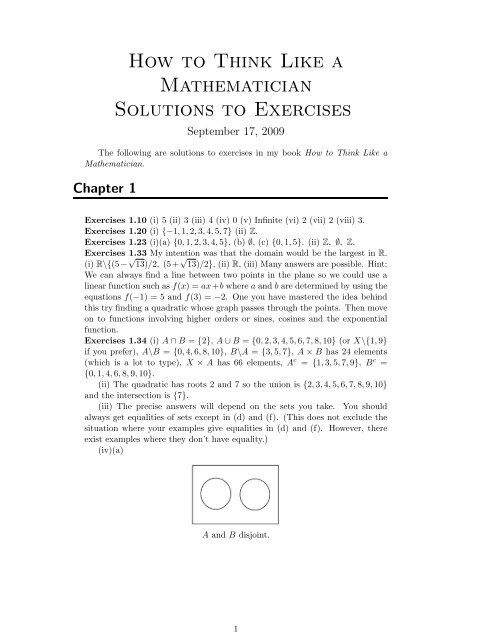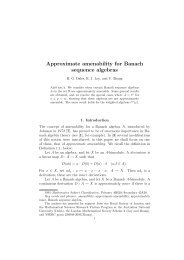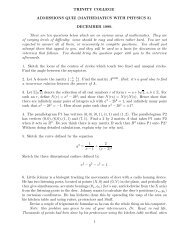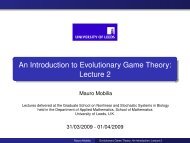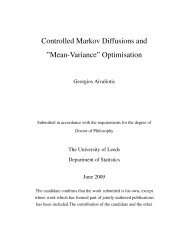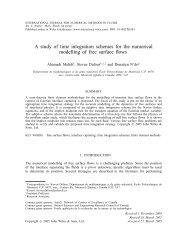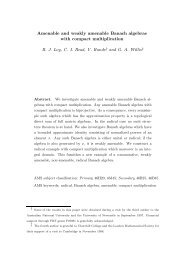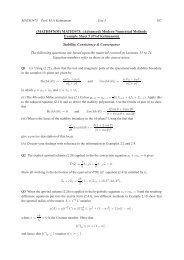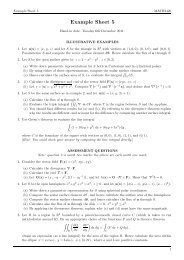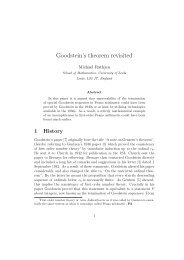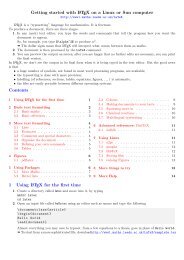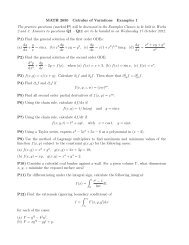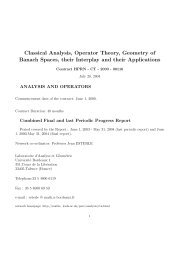Solutions to How to Think Like a Mathematician - School of ...
Solutions to How to Think Like a Mathematician - School of ...
Solutions to How to Think Like a Mathematician - School of ...
- No tags were found...
You also want an ePaper? Increase the reach of your titles
YUMPU automatically turns print PDFs into web optimized ePapers that Google loves.
<strong>How</strong> <strong>to</strong> <strong>Think</strong> <strong>Like</strong> a<strong>Mathematician</strong><strong>Solutions</strong> <strong>to</strong> ExercisesSeptember 17, 2009The following are solutions <strong>to</strong> exercises in my book <strong>How</strong> <strong>to</strong> <strong>Think</strong> <strong>Like</strong> a<strong>Mathematician</strong>.Chapter 1Exercises 1.10 (i) 5 (ii) 3 (iii) 4 (iv) 0 (v) Infinite (vi) 2 (vii) 2 (viii) 3.Exercises 1.20 (i) {−1, 1, 2, 3, 4, 5, 7} (ii) Z.Exercises 1.23 (i)(a) {0, 1, 2, 3, 4, 5}, (b) ∅, (c) {0, 1, 5}. (ii) Z, ∅, Z.Exercises 1.33 My intention was that the domain would be the largest in R.(i) R\{(5− √ 13)/2, (5+ √ 13)/2}, (ii) R, (iii) Many answers are possible. Hint:We can always find a line between two points in the plane so we could use alinear function such as f(x) = ax+b where a and b are determined by using theequations f(−1) = 5 and f(3) = −2. One you have mastered the idea behindthis try finding a quadratic whose graph passes through the points. Then moveon <strong>to</strong> functions involving higher orders or sines, cosines and the exponentialfunction.Exercises 1.34 (i) A ∩ B = {2}, A ∪ B = {0, 2, 3, 4, 5, 6, 7, 8, 10} (or X\{1, 9}if you prefer), A\B = {0, 4, 6, 8, 10}, B\A = {3, 5, 7}, A × B has 24 elements(which is a lot <strong>to</strong> type), X × A has 66 elements, A c = {1, 3, 5, 7, 9}, B c ={0, 1, 4, 6, 8, 9, 10}.(ii) The quadratic has roots 2 and 7 so the union is {2, 3, 4, 5, 6, 7, 8, 9, 10}and the intersection is {7}.(iii) The precise answers will depend on the sets you take. You shouldalways get equalities <strong>of</strong> sets except in (d) and (f). (This does not exclude thesituation where your examples give equalities in (d) and (f). <strong>How</strong>ever, thereexist examples where they don’t have equality.)(iv)(a)A and B disjoint.1
(b)A ∪ B A C (A ∩ B) c(c) An example <strong>of</strong> from (i):(v) Not applicable.Chapter 2(A ∩ B) ∪ (A ∩ B) or A ∩ (B ∪ C).<strong>Solutions</strong> not applicable <strong>to</strong> this chapter.Chapters 3 and 4The solutions <strong>to</strong> these chapters will depend on your personal answers and writingstyle.Exercises 3.2 (i) Don’t forget <strong>to</strong> explain what a, b, c, α, β, γ and h are andexplain what are assumptions and what are conclusions.(ii) There are some mathematical mistakes. The second line is actuallyf ′ (x) yet the student has equated it <strong>to</strong> f. Also they say (taking in<strong>to</strong> accountthe previous comment) that f ′ (x) = 6x 2 − 24x + 18 implies that x = 1 and3. This is not true, it is the equation f ′ (x) = 0 that gives us the values for x.Equality signs are missing in the calculation <strong>of</strong> x. Some notation is missing.When finding maxima and minima we put the values <strong>of</strong> x in<strong>to</strong> the expressionfor the second derivative and so we should really haveChapter 5d 2 ∣y ∣∣∣x=1dx 2 etc, rather than just d2 ydx 2 .The point <strong>of</strong> this chapter is <strong>to</strong> get you thinking about solving problems and sogiving the answers would defeat the purpose <strong>of</strong> the chapter. Keep coming back<strong>to</strong> them! <strong>How</strong>ever, I should say that (v) and (vi) are classics and so you shouldbe able <strong>to</strong> find some answers with a web search.2
Chapter 6Exercises 6.10 Both truth tables should have the following formA B ∼F F TF T FT F FT T FExercises 6.11 (i) Statements: (a), (d) and (e). Statement (d) is true but thetruth or otherwise cannot be known for (a) and (e). (Well, (e) will be known ifyou are reading this after 2089.)(ii) The truth table should beA B (a) (b) (c) (d) (e) (f)F F T T T T T FF T T F T F T FT F T F T T T FT T F F F T T F(iii)(a) A is false and B is true. (b) A is true and B is false. (c) A is falseand B is false. (d) A is false or B is false.(iv) The truth tables look like the followingA B C (a) (b) (c)F F F F F FF F T F T TF T F F F FF T T F T FT F F F F FT F T T T FT T F T T FT T T T T F(v)(a) The truth table can be constructed as follows:A not A A or (not A)F T TT F T(b) not(A and not A)(c) Yes, it is but maybe I should have put this question in one <strong>of</strong> the chapterson implications.(d) The truth table looks likeA not A A and (not A)F T FT F F3
Chapter 24Exercises 24.10 (i) Similar <strong>to</strong> Example 24.4.(ii) Similar <strong>to</strong> Example 24.7.(iii) Similar <strong>to</strong> Example 24.6.(iv) We’ll prove that 17 divides 3 4n +4 3n+2 for all n ∈ N as a worked example.(If this wasn’t an exercise in a chapter on induction, then, because <strong>of</strong> the n ∈ Npart, alarm bells should ring in your head and you should au<strong>to</strong>matically think‘I’ll use induction’.)Initial case: We want <strong>to</strong> show that 17 divides 3 4n + 4 3n+2 when n = 1. Wehave that3 4n + 4 3n+2 = 3 4×1 + 4 3×1+2= 3 4 + 4 5= 81 + 1024= 1105= 17 × 65.So 17 divides 3 4n + 4 3n+2 when n = 1.Induction step: Now suppose that 17 divides 3 4n + 4 3n+2 when n = k forsome particular k, i.e.,3 4k + 4 3k+2 = 17m for some m ∈ Z.Let’s consider the expression for n = k + 1:3 4(k+1) + 4 3(k+1)+2 = 3(4k+4 + 4 3k+5= 3 4k) 3 4 + 4 3k+5(= 17m − 4 3k+2) 3 4 + 4 3k+5 ,by the inductive hypothesis,= 17m × 3 4 − 4 3k+2 × 3 4 + 4 3k+5= 17m × 3 4 − 4 3k+2 × 3 4 + 4 3k+2 × 4 3= 17m × 3 4 − 4 3k+2 × ( 3 4 − 4 3)= 17m × 3 4 − 4 3k+2 × (81 − 64)= 17m(× 3 4 − 4 3k+2 × 17= 17 m × 3 4 − 4 3k+2) .So 17 divides 3 4(k+1) + 4 3(k+1)+2 as required.We have shown that the statement for n = k implies that the statement forn = k + 1 is true. Therefore by the Principle <strong>of</strong> Mathematical Induction thestatement is true for all n ∈ N. That is,17 divides 3 4n + 4 3n+2 for all n ∈ N.(v) Hint: sin(n + 1)x can be taken <strong>to</strong> be the ‘complicated’ side as we canexpand it <strong>to</strong> something else. Also −1 ≤ cos θ ≤ 1.4
(vi) Hint: In the induction step we can show that(x + y)(x + y) k = (x + y)=k∑r=0k∑r=0( kr)x k−r y r( kr)x k−r+1 y r +k∑r=0( kr)x k−r y r+1At this point a number <strong>of</strong> students start writing out the summations in full sothat they rearrange and gather them <strong>to</strong>gether. I.e., they would like <strong>to</strong> gatherthe terms x a y b from the two summations. We can do this by ‘changing thevariable’ in one <strong>of</strong> the summations.Let s = r + 1, so when r = 0, s = 1 and when r = k, s = k + 1. We alsohave r = s − 1. Then the second summation can be changed:k∑r=0( kr)x k−r y r+1 ==∑k+1( ) kx k−(s−1) y (s−1)+1s − 1s=1∑k+1( ) kx k−s+1 y s .s − 1s=1Now here’s the part that upsets some people. The summation does not dependon the name <strong>of</strong> the variable used in the summing and so I can change the s <strong>to</strong>r. But s = r − 1 they say, we can’t take s = r. The answer is that this r isdifferent <strong>to</strong> the previous r. Sounds confusing but mathematicians do this type<strong>of</strong> change all the time!We have∑k+1( ) kx k−s+1 y s =s − 1s=1∑k+1r=1In conclusion this means we have shown thatk∑r=0Thus we get that(x + y)(x + y) k =( kr)x k−r y r+1 =r=0∑k+1r=1( ) kx k−r+1 y r .r − 1( ) kx k−r+1 y r .r − 1k∑( k ∑k+1( ) kxr)k−r+1 y r +x k−r+1 y r .r − 1From here you can separate out the term r = 0 in the first summation andr = k + 1 in the second so that you can add the two remaining parts <strong>of</strong> thesummations <strong>to</strong>gether.In my original notes for the solution <strong>to</strong> this problem I added <strong>to</strong>gether ( )krand ( kr−1)by using the definition in terms <strong>of</strong> fac<strong>to</strong>rials. Instead you can use theidentity from the statement <strong>of</strong> exercise (viii), which amounts <strong>to</strong> the same thing.(vii) Change n 2 −1 <strong>to</strong> (2n−1) 2 −1 as described on page 172. In this exercisewe can also prove the statement by the direct method. It is easy <strong>to</strong> calculatethat (2n − 1) 2 − 1 = 4n(n − 1). Now for any n either n or n − 1 is even andhence so is their product. This means that n(n − 1) = 2m for some m ∈ Z.r=15
Therefore, (2n − 1) 2 − 1 = 4 × 2m = 8m and we can conclude that the numberis divisible by 8.(viii) Similar <strong>to</strong> (vi).(ix) Similar <strong>to</strong> Example 24.4 and exercise (i) but with more complicatedalgebraic manipulation. A surprising result, don’t you think? That the square<strong>of</strong> the sum <strong>of</strong> the first n numbers is equal <strong>to</strong> the sum <strong>of</strong> the cubes <strong>of</strong> the first nnumbers is surprising <strong>to</strong> me.(x) This exercise is incorrect. The statement is not even complete. See thecorrections on the website.(xi) This question is about counting subsets and <strong>to</strong> some extent about howyou organize your writing <strong>of</strong> mathematics. In the inductive step we considerthat X has k + 1 elements and so it contains a subset Y <strong>of</strong> k elements so thatX = Y ∪ {x} for some x ∈ X. By the inductive hypothesis Y has 2 k subsets.As Y is a subset <strong>of</strong> X, it must be true that X has these as subsets <strong>to</strong>o. Nextwe can see that if Z is a subset <strong>of</strong> Y , then Z ∪ {x} will be a subset <strong>of</strong> X that wehaven’t already counted. There should therefore be 2 k <strong>of</strong> these. Thus X shouldhave 2 × 2 k subsets. The aim <strong>of</strong> the exercise is <strong>to</strong> rigorously count these subsetsand <strong>to</strong> write your answer so that is comprehensible. This is the organizationalpart, you need <strong>to</strong> give good notation so that the counting process is easy/clear.(xii)(a) The inductive hypothesis is x k − 1 = m(x − 1) for some m ∈ Z sox k = m(x − 1) + 1. The rest is just algebra. (b) The formula isx n − 1x − 1 = xn + x n−1 + · · · + x + 1and the latter can be written succinctly as ∑ ni=0 xi .(xiii) We have2 n < 2 n−1 ⇐⇒ 2.2 n−1 < 2 n−1 ⇐⇒ 2 < 1.So the statement is false. It is important that we use ⇐⇒ , see Chapter 21 oncommon mistakes. The induction step should be straightforward.(xiv) The induction step involves dealing with the two cases, ∀ and ∃, separately.(xv) This one should be straightforward as I think that neither side <strong>of</strong> theinequality is more complicated than the other so it doesn’t matter which youpick <strong>to</strong> work on.(xvi) The algebra for this is the hardest part so don’t worry if your answeris long. You may need <strong>to</strong> use the formula in (xii)(b). The problem is aboutcomparing the arithmetic and geometric means <strong>of</strong> a collection <strong>of</strong> numbers.Chapter 25Exercises 25.2 (i) One answer is that the pro<strong>of</strong> goes wrong for k < 7 simplybecause those cases are not true. I.e., the initial case is missing. One could alsoargue that – sometimes – the induction step is false when k < 7. That is, in6
the pro<strong>of</strong>, k 2 + 3k ≤ k 2 + k × k is true for k ≥ 7 but in fact it is also true fork ≥ 3 while not true for k = 1 and 2.(ii) Similar <strong>to</strong> (i). The inductive step is true for all k ≥ 1.(iii) Hint:Exercises 25.4 (i) The two initial cases are easy. The induction step is morecomplicated. Here’s how I would attempt it. I am trying <strong>to</strong> show you that,sometimes, solving a problem involves dead ends and refinement and that itmay not be obvious, after it is written up, where the answer came from.Let’s begin the pro<strong>of</strong> <strong>of</strong> the induction step: Assume that A(k) and A(k − 1)are true, i.e., x k < ( 74) k and xk−1 < ( 74) k−1. Thenx k+1 = x k + x k−1 , by definition,
So let’s try again:x k+1 = x k + x k−1 , by definition,
The other details are fairly straightforward.In fact, it is possible <strong>to</strong> prove that x 3n = ∑ n( ni=1 i)2 i x i . You may like <strong>to</strong>attempt the pro<strong>of</strong> <strong>of</strong> this.(d) The formula is ∑ ni=1 x 2i−1 = x 2n .(e) The formula is ∑ ni=1 x 2i = x 2n+1 − 1.2(ii) It is easier if you simplify thek−1type terms first but this is not strictly3×2 2k−2necessary. Also, don’t forget that(−1) k+1 = (−1) 2 (−1) k−1 = 1.(−1) k−1 = (−1) k−1 .(iii) The fac<strong>to</strong>rization can be done in a number <strong>of</strong> ways (we don’t needinduction). I can see that 12870 is divisible by 10 and so 2 and 5 are fac<strong>to</strong>rs.So I need <strong>to</strong> fac<strong>to</strong>r 1287. To do this I find the square root as it gives me thehighest number that I need <strong>to</strong> check <strong>to</strong> find a fac<strong>to</strong>r. If there is a fac<strong>to</strong>r greaterthan the square root it must be balanced by one smaller than the square root.(<strong>Think</strong> about it.) My calcula<strong>to</strong>r gives √ 1287 = 3 √ 143 from which I deducethat 3 2 is a fac<strong>to</strong>r <strong>of</strong> 1287. I now need <strong>to</strong> fac<strong>to</strong>r 1287/9 = 143. Again I usemy calcula<strong>to</strong>r, this time it says that √ 143 ≃ 11.95 so I need only <strong>to</strong> checkdivisibility by the primes from 2 <strong>to</strong> 11. <strong>How</strong>ever, when thinking about 11 Inotice that the number 143 is <strong>of</strong> the form abc where a + c = b and so I knowthat 143 is divisible by 11. I can work out that 143/11 = 13. This is prime soI can now s<strong>to</strong>p my fac<strong>to</strong>rization.Putting this all <strong>to</strong>gether we get12870 = 2.5.3 2 .11.13.The number 17836 is done in a similar manner. I can see that the numberis even so I can divide by 2. The resulting number is even also and so I candivide by 2 again. Alternatively, I can see that the last two digits are divisibleby 4 and so the number itself is divisible by 4. (A pro<strong>of</strong> <strong>of</strong> this is required inExercises 27.23(ix)(b)).We have 17836/4 = 4459. This is not even so is not divisible by 2. Again Ifind the square root so that I have a bound on the fac<strong>to</strong>rs I should look for, here√4459 = 7√91. Thus, 4459 = 7 2 × 91. Assuming I don’t know the divisors <strong>of</strong>91 I reach for my calcula<strong>to</strong>r again and get √ 91 ≃ 9.5 so we only need check theprimes 2, 3, 5, and 7 for divisibility. Obviously 2 and 5 can be ignored as 91 isnot even and does not end in 0 or 5. Also, 3 can be discarded as 90 is obviouslya multiple <strong>of</strong> 3. This leaves 7, a quick calculation shows that 91/7 = 13. Asthis is prime we s<strong>to</strong>p.Putting it all <strong>to</strong>gether we get:17836 = 4 × 7 2 × 7 × 13 = 2 2 .7 3 .13.Kevin Hous<strong>to</strong>n<strong>School</strong> <strong>of</strong> MathematicsUniversity <strong>of</strong> LeedsLeedsUKLS2 9JTk.hous<strong>to</strong>n@leeds.ac.ukwww.maths.leeds.ac.uk/∼khous<strong>to</strong>n9


